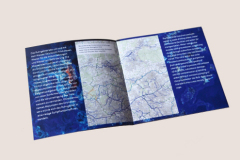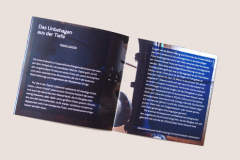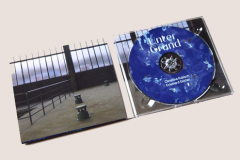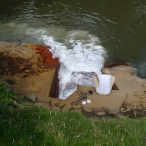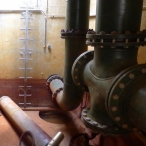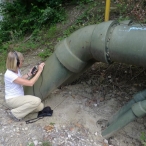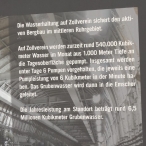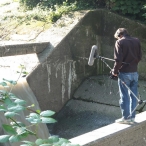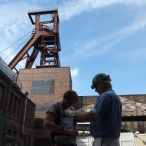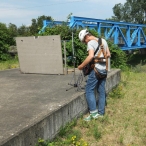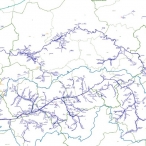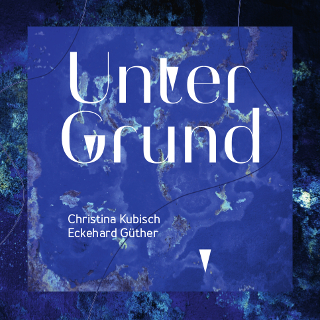
Unter Grund | Christina Kubisch & Eckehard Güther
English | Deutsch
Gruen 160 | Audio CD > [Bestellung]
Reviews
Das Ruhrgebiet lebt von und mit dem Wasser. Es braucht Trinkwasser, Wasser für die Industrieanlagen und Wasser zur Beförderung. Die Wasseradern pulsieren unsichtbar als Grundwasser, verbinden Flüsse durch unterirdische Kanäle und dringen auch in die ehemaligen, jetzt stillgelegten Bergwerke ein. Dieses Grubenwasser muss unaufhörlich abgeleitet bzw. unter Tage abgepumpt werden (man spricht von Ewigkeitsaufgaben), um den Einsturz von alten Schächten, Bergschäden und die Verunreinigung des Trinkwassers zu vermeiden. Ohne permanentes Abpumpen des Grundwassers würde sich das Ruhrgebiet in eine riesige Sumpflandschaft verwandeln.
Fabian Lasarzik
Das Unbehagen aus der Tiefe
Christina Kubischs ortsspezifische Klanginstallationen beruhen auf dem Aufspüren von parallelen Welten. Dabei geht sie oft auf vorgefundene Strukturen eines Ortes ein, seine Atmosphäre und seine unentdeckten Resonanzen, die sie in die konkrete Wahrnehmung und Imagination der Rezipienten bringt.
Für die in der Zeche Zollverein realisierte 26-kanalige Installation „Unter Grund“ untersuchte Christina Kubisch die unterund auch die überirdischen Wasserläufe, die im Bergbau eine wenig bekannte, aber dafür umso größere Rolle spielen: Wasser, das aus den leerstehenden, nicht wieder verfüllten Schächten abgepumpt und in ein komplexes Fluss- und Kanalsystem eingelassen werden muss.
Es geht um die Beherrschung und Kontrolle des Grubenwassers, das nichts anderes ist als aufsteigendes, in die ehemaligen Flöze eindringendes und in der Tiefe versickerndes Grundwasser. Dieses Wasser muss permanent abgepumpt und abgeleitet werden. Ohne diese aufwendige Wasserhaltung würden die Tunnelsysteme geflutet, was zu Bewegungen an der Oberfläche führen würde. Schon jetzt ist die Region im Ruhrgebiet an manchen Stellen bis über 20 Meter in den letzten 150 Jahren „abgesackt“. Ebenso würde sich das saure Grubenwasser mit unserem normalen Grundwasser vermischen und es chemisch verunreinigen. Es würde steigen, bis das Ruhrgebiet zu einer sumpfigen Seenlandschaft mit kontaminiertem Wasser würde. Allein auf Zollverein stehen in 1000m Tiefe sechs Horizontalkreiselpumpen, zwei davon sind ständig in Betrieb. Durchschnittlich werden hier jährlich rund 8 Mio. Kubikmeter Wasser abgepumpt. Wenn man von Ewigkeitslasten- oder kosten spricht, sind diese gewaltigen Anstrengungen gemeint.
Die enormen Konsequenzen und Maßnahmen entsprechen den ungeheuren historischen Eingriffen, die der Bergbau mit sich gebracht hat und die der Öffentlichkeit kaum bewusst sind.
Die künstlerische Feldforschung Christina Kubischs thematisiert diese parallele Welt. Mit großer Sensibilität in der klanglichen Inszenierung befördert sie die dunkle Dimension unserer Imagination, die das Unsichtbare „unter dem Grund“ mit dem Unheimlichen, dem unkontrollierbaren Ursprünglichen assoziiert. Übertragen gesprochen hat das Sujet mit dem Bewussten und dem Unbewussten zu tun: der transparenten und im Sinne des Wortes lichten Wirklichkeit über Tage im Gegensatz zur dunklen, unheimlichen, verborgenen Wirklichkeit unter Tage. Christina Kubisch transportiert diese Aspekte in eine Raumkomposition mit unter und über Tage aufgenommenen Fieldrecordings. Was wir hier hören ist Wirklichkeit, die sinnlich erfahrbar wird innerhalb einer Komposition, die geschickt dokumentarisches Material mit unserer Imagination verbindet. Lässt man sich auf die durch das Werk angeregte Imagination ein, so spürt man, was für ungeheure Dinge unter unseren Füßen passierten, dass sich Menschen mit dem Erdinnern und den Kräften der Natur „gemessen“ haben. Assoziativ steht „unter Tage“ – wir sprechen hier von Tiefen bis zu 1400m – für das Unbewusste, das Archaische, das Langvergessene. Schließlich stehen wir auf dem, was sich seit Millionen von Jahren abgelagert hat und von dem wir wenig wissen, außer, dass es gewaltig ist und vor der Menschwerdung schon begonnen hatte.
Unsere Urangst an dieser Stelle ist, dass sich die ursprünglichen Dinge (im Grunde die Natur selbst) gegen uns richten, sich rächen. Christina Kubischs Arbeit spielt mit diesen Assoziationen ohne Pathos. Beim Erklingen der basslastigen gewaltigen Hauptwasserpumpen scheint es, als hörten wir das Aus- und Einatmen eines unter uns liegenden riesigen Organismus. Die Klänge deuten Größe, Bedeutung und Bedrohlichkeit an. Wir werden etwas gewahr, dass wir sonst nicht wahrnehmen würden. Kubisch nutzt ausgerechnet militärische Gerätschaften wie spezielle Hydrophone, um diese parallelen Welten erfahrbar zu machen, und sie tut es wahrscheinlich mit einer gewissen subversiven Freude. Es geht nicht allein um pittoreske Klänge und spannende Geräusche, sondern auch um alternative Weisen des Wahrnehmens, des Erschließens von Zusammenhängen. Das ist ihr tiefgehender konzeptueller Ansatz. Bei Kubisch geht es vor allem um autonom ermöglichte Wege der Erfahrung und inoffizielle Lesarten der Wirklichkeit. Darin liegt auch ein ironischer Seitenhieb auf unseren Glauben an den technischen Fortschritt, der uns einerseits die Welt eröffnet, der aber mit seiner Ausrichtung auf bestimmte Entwicklungslinien uns gleichzeitig mit Blindheit schlägt. (Gesamttext – PDF)
TRACK 1: Unter Grund: 23:47 min
MP3
TRACK 2: Vision: 8:28 min
MP3
2 Tracks (32′15″)
CD (500 copies)
„Unter Grund “ wurde 2014 im Rahmen des Festivals NOW/Parallele Welten in Form einer 26-kanaligen Klanginstallation auf dem Welterbe Zeche Zollverein gezeigt. Die gleichnamige Komposition auf der CD besteht aus Aufnahmen, die im Ruhrgebiet in über- und unterirdischen Maschinenräumen, Pumpstationen, Wasserwerken, Teichen, Schachtsümpfen, Förderkörben, Abflusskanälen etc. gemacht wurden. Einige Aufnahmen stammen direkt von Schacht XII der ehemaligen Zeche Zollverein. Die Tonaufnahmen wurden vorwiegend mit Hydrophonen und Kontaktmikrophonen gemacht.
CONCEPT: Christina Kubisch
CURATOR: Fabian Lasarzik, artistic director Stiftung Zollverein
FIELD RECORDINGS: Eckehard Güther, Christina Kubisch
SOUND ENGINEERING: Eckehard Güther
MASTERING: Douglas Henderson
PRODUCED AT: Studio Hoppegarten and Visby International Centre for Composers (VICC), Gotland, Sweden
PRODUCER: Gruenrekorder
THANKS TO: Emscher Genossenschaft, RAG Stiftung
CONSULTING: Uwe Rüth
DESIGN: Sebastian Ristow / FLATLAB
COVERFOTOS: Christina Kubisch, 2001, fluorescence photography.
SOUNDSCAPE SERIES BY GRUENREKORDER
in Kooperation mit Stiftung Zollverein
Germany / 2015 / Gruen 160 / LC 09488 / GEMA / EAN: 4050486942062
Beach Sloth
Finding the mysticism in everyday life, Christina Kubisch & Eckehard Güther sculpt elaborate electro-acoustic field recordings with “Unter Grund”. Quite lush in terms of their sonic detail not a single element goes unnoticed. Much of the sound has a journey-like quality to it while the origin of the sound slowly comes into view. By opting for such a style the pieces resonant on an intellectual as well as an emotional level. Sounds positively teem with life for the duo chooses to amplify the busy moments in a life that so often go completely unnoticed.
By far the highlight of the album comes with the title track and opener “Unter Grund”. Aptly named, the way the song evolves is one that feels nearly submerged most of the time. Liquids slosh about with a vigorous energy. Melody and rhythm emerge though in an extremely indirect way. Layer upon layer of sound is applied in a masterful way while the entirety of the sonic spectrum does wonders in terms of letting piece expand upon its limited view. Gradually the rest of the world comes into view while the piece itself gets quite heavily saturated. For the latter half of the piece the duo descends into a virtual cacophony, far away from the gentle beginnings. Closing things on a reflective note is the sedate style of “Vision” where the sound ebbs and flows until it evaporates away.
Christina Kubisch & Eckehard Güther craft impeccable worlds with the expansive and ambitious scope of “Unter Grund”.
link
Aurelio Cianciotta | Neural
Unter Grund was presented in 2014 in the context of the NOW/ Parallele Welten festival, in Zollverein, the world heritage site of the German Customs Union. That 26 channel sound installation is now condensed in field recordings captured throughout the Ruhr area, mainly in machine rooms, above or under ground, pumping stations, waterworks, ponds, shaft sumps, cages and spillways – just some of the industrial locations that were the object of Christina Kubisch and Eckehard Güther’s research. The Ruhr area is now one of the largest conurbations in Europe and while this industrial heritage remains intact, it is also one of the places in the world with the highest concentration of museums dedicated to modern art. Ruhr then is a place that exemplifies the changes that are possible through culture, where defunct industrial infrastructures become new cultural stages. It is not surprising that the artists focus here on water (drinking water, water for industrial facilities and water for transportation), because without constant pumping of the groundwater, that region would transform into a vast marshy landscape. The two sound-artists have used contact microphones and hydrophones. Everything is strictly site-specific, with a particular grain given by the alternation and coexistence of natural and industrial sounds, fluidity and strength, underground and explicit, which they have materialized into a rich soundscape, finally unexpected. Unter Grund is released in their Soundscape Series instead in the other series dedicated only to variously combined field recordings.
link
Ed Pinsent | The Sound Projector
We’ve heard a few items from German sound artist Christina Kubisch over time, but not encountered many instances of her installation work, so it’s good to get our ears around this copy of Unter Grund (GRUENREKORDER Gruen 160). These two tracks might be taken as a partial, representative snapshot of a much larger and highly ambitious 26-channel installation piece which she made at the Zollverein Coal Mine Industrial Complex in Essen. It’s to do with water streams both above ground and below the ground, and her work has led her into a detailed research of the history and geography of the area, as well as an understanding of the workings of this 19th-century mineshaft.
Zollverein, now inactive, became a UNESCO world heritage site a few years ago, but the rugged beauty of the equipment is not what interests Kubisch; rather, she is keen to point out the profound changes that intensive mining has wrought on the land, not to mention the hints of ecological damage, alluding to the Ruhr area being gradually changed into a “swampy seascape with contaminated water”. More than that, she’s intrigued by the power of this elaborate tunnelling system, an industry that required permanent pumping and transport of mine water just to keep operating. The piece gradually becomes more abstract and conceptual in nature (at any rate, the sleeve notes go that way), conveying something about our primordial fears of unseen, underground forces; and terrors of how nature may one day turn against us.
For a similar exploration of water coursing through a vast industrial complex, see To The Cooling Tower, Satsop by Christopher DeLaurenti, which I reviewed in 2015. Kubisch may share some of the American’s critical view of modern industry, and I think they are both aware of how the realities of these things tend to get covered up by political forces and other agencies who would simply prefer us not to find out about the extent to which our planet is being altered by these interventions. However, Kubisch is less interested in the aesthetical transformation of these sounds, and the record is pretty much a stern, unblinking documentary of water passing above and below ground, with zero electro-acoustic manipulation. That said, it still passes on the sensations of anxiety and doom she is attempting to convey. A full colour booklet provides photos and annotations of this awe-inspiring work.
link
The Wire Magazine | Issue 387
Ceaseless extraction of groundwater from a network of disused mines is required to prevent Germany’s Ruhr district from meeting a soggy fate. Without the constant operation of underground pumps the region would become an uninhabitable quagmire. In collaboration with sound engineer Eckehard Güther, sonic topographer Christina Kubisch tracked the Ruhr’s subterranean waterways, took samples, and diverted their acoustic energy into a 26-channel installation. The project also found room for noises of heavy machinery, designed to limit physical subsidence and the contamination of drinking water. Unter Grund is a tributary from that installation, a stereo composition that recycles recordings made – mainly with hydrophones and contact mics – in pumping stations, ponds, waterworks and mineshaft sumps. Kubisch draws a psychogeographical aura from her field captures, revealing an occult dimension through the trickles of an underground stream or the churning of industrial apparatus.
link
Duncan Simpson | Musique Machine
Unter Grund is a two part composition originally produced as a sound installation for the NOW / Parallele Welten festival in 2014 at the Zollverein coal mining site near Gelsenkirchen. The choice of location was apt as the material which makes up this recording is principally derived from underground sources involving mines, pumping stations and other machinic locations associated with the Ruhr area which have some connection to water.
The liner notes describe Kubisch’s work as being about „alternative ways of perceiving and accessing correlations“ and „autonomously provided ways of experience and unofficial versions of reality“. The choice of source material brings together historical themes of technological progress and the costs to the environment but also more socially minded reflections on the lives of miners „competing with the bowels of the earth“.
The first part is the longest at nearly twenty four minutes and starts with regular splashes seemingly from a pumping system of sorts. We quickly depart from this more recognisable sound as Kubisch and sound engineer Eckehard Güther’s hydrophones descend into the water picking up all manner of low drones and far away industrial noises. Contact microphones are also liberally deployed picking up characteristically uncanny sounds in the intimacy of their locations. I find there is always something a little claustrophobic in the sounds picked up by contact mics; the little clicks and rubs which are amplified as if they were occurring right next to your eardrum. The Ruhr area has apparently sagged more than twenty meters over the last 150 years as a result of the mining activity and subsequent flooding by ascending ground water. Indeed it is these pumps recorded by Kubisch which are keeping the area from turning into a vast swamp. These recordings – as the artist appears to intend – open up a secret world beneath the earth, one which harks back to the birth of Germany as Europe’s industrial power house, but it is clear by the fact of the pumping and draining system’s constant operation that „progress“ has come at a high price.
Later in the piece almost pastoral trickles and flows of water are rudely interrupted by what could be the sound of a giant washing machine clicking into a spin cycle but what is probably a centrifugal pump deep beneath the earth.
The second shorter piece begins with more delightful close recordings of quiet sounds. Even some insects and frogs seem to get in on the act providing a nice counterpoint to the strange whirring slurping and rhythmic movements of water. This piece which is titled Vision is a lot brighter than the title piece, with less drone and more air so to speak. Perhaps as the title suggest these sources are above ground within the field of vision. Whatever the sources the two pieces together complement each other nicely and achieve well the artist’s aim of offering up to the listener’s imagination the unheralded vibrancy of these lesser known realities.
This is the second recording I have heard from the Gruenrekorder label after last year’s hugely impressive Landscapes of Fear compilation. They are building a solid reputation as a label with a well tuned ear for the best in contemporary phonography and sound art.
link
Richard Allen | a closer listen
Many of the water-based recordings we receive are beauty-based, calling to mind vacations by the sea, meditations by the river, the sweetness of summer rain. Christina Kubisch & Eckehard Güther‘s Unter Grund is different: historical, political and metaphorical, it prompts the listener into larger modes of thought.
The original presentation was a 26-channel installation, and we’re intensely jealous of those who were able to check it out. The CD version is an intricate soundscape of water movement in the Ruhr area, recorded above and below ground, in spouts and pipes, pumps and ponds. The expanded recording area paints a fuller picture of water flow than one might receive from the personal experience of water from faucets and shower heads, heaters and drains. Where does the water come from? Where does it go? Is it clean? Few people ask such questions, content to trust that what enters their homes must be pure. And yet an entire industry exists to verify that it is.
In the Ruhr area, this means that water must be pumped from underground (unter grund) in a continual process that preserves the integrity of the mine shafts and the chemical content of the liquid. This unseen duty is left to a handful of workers whose contributions remain largely unnoticed. Yet without them: disaster, drought, plague. The dark timbres of these compositions ~ forlorn drones, low-pitched splashes, subterranean rumbles ~ conjure images of the conditions of these former coal mines, blackened by pitch and blood. Out of sight, out of mind, and yet the life of the entire area depends on the success of a few. One might go deeper, both literally and metaphorically, to imagine the low light of the depths, the cold, dank odors, the sedimentary layers, the mouth of Hell. And yet from the depths of the earth comes life, aided in this case by human intervention, reflecting the work of the divine.
As the album develops, it grows first darker, then lighter, spilling from the mechanical to the natural. When the first birds make their appearance, the listener feels a sense of palpable relief, akin to that a trapped miner might feel upon seeing a shaft of sun. Kubisch and Güther train this light on the depths so that they might be illuminated: minds opened, appreciation restored.
link
textura
Since its 2003 founding, Gruenrekorder co-managers Lasse-Marc Riek and Roland Etzin have done much to establish the German label as one of the foremost outlets for field recordings-related work, and for that matter have been instrumental in establishing field recordings as a legitimate stand-alone genre. Two new releases, the first by Christina Kubisch and Eckehard Güther and the other by Thomas M. Siefert and Riek (under the rhein_strom name), reflect that ongoing commitment; Riek’s also represented here by Schwarm, an hour-long recording that while issued on ALARM could just as easily have appeared on Gruenrekorder.
Though the two Gruenrekorder releases are classified differently, Kubisch and Güther’s as part of the label’s Soundscape Series and rhein_strom’s as a Field Recording Series installment, they have more in common that that distinction might suggest: both are grounded in field recordings activity and, as a result of the manipulations applied to them by the artists involved, are soundscapes, too. In terms of content, both also are conceptually oriented around water-related activity. As always with the label’s products, the visual presentation adds considerably to one’s impression of the material, with each release enhanced by texts and photos to bring clarity to the project and the artists‘ intentions.
At thirty-two minutes, Unter Grund (Under Ground) is more than half the length of von der rheinquelle bis hafen karlsruhe but isn’t compromised by brevity. To create the work, originally presented as a twenty-six-channel installation at the Zollverein world heritage site, Güther and Kubisch used hydrophones and contact microphones to gather recordings in the Ruhr Area in machine rooms (above and under ground), pumping stations, waterworks, ponds, shaft sumps, cages, and spillways, among other locales. In keeping with its title, Unter Grund obviously is as much about what’s happening below as above the surface, specifically groundwater that connects rivers through subsurface tunnels that push their way into disused mines and must therefore be drained or pumped so as to avoid drinking water contamination and the collapse of old shafts. In simplest terms, mine water must be managed and controlled as without doing so the tunnel system would flood, which would in turn induce sag on the land surface, soil the water chemically, and essentially convert the Ruhr area into a swampy, contaminated seascape.
An obvious parallel can be drawn between the activities above and below ground and the conscious and unconscious parts of the Freudian psyche. There’s an omnipresent tension between what we can know and see and thereby control versus primordial urges operating below the surface. Similar to that, we witness nature’s merciless power in its extreme weather patterns and volcanic activity but can only guess at what’s going on under our feet at any given moment. It’s understandable, then, that the portrait drawn on Unter Grund is neither pastoral nor bucolic. Instead, the listener is repeatedly reminded of the immense strength of the forces operating underground and the potential harm they could cause were they to go unchecked.
In the soundscape, Kubisch and Güther conjure a turbulent world that while not nightmarish is often ominous in tone. When the water pump roars into hydraulic action at the thirteen-minute mark and even more dauntingly nine minutes later, we start to gain some sense of the complex industrial operation involved in releasing the water from its underground channels. At such moments, the soundscape becomes more of a churning noisescape than anything else. Upholding the material’s alien tone, “Vision” concludes the release with eight minutes of insectoid noise that suggests the inner workings of the human body as much as earthly activity. […]
link
Frans de Waard | VITAL WEEKLY
Two new releases by Gruenrekorder, who now clearly state on the cover of which series these releases are part. Thus we learn that the release by Christina Kubisch and Eckehard Güther is part of the soundscape series. I am not sure if I heard of Güther before, but surely I did of Kubisch, even when in recent times she seemed more active in building sound installations rather than releasing music on CD. This new CD however is a bit of both: it is a CD (obviously), documenting a sound installation, which had no less than twenty-six channels, and which uses the sound of water from the Ruhrgebiet area. To be more precise water that is underground, in old and disused mines and they have to be clear of water, so pumping goes on and on, as one doesn’t want the water to mix with the normal groundwater, out of fear for contamination. Kubisch and Güther did all the field recordings and I think its
Kubisch who is responsible for the composition as such. Two pieces here and there is of course an interesting parallel to be drawn to the world of music (rather than pure documentation of a sound event), industrial music to be precise. Much of this deals with the sound of machines, pumps, pipes and mechanics. And of course the sound of water, running through these pumps and pipes. Kubisch creates a truly fascinating sound world with these sounds, and it might be that I am biased and love motorized sound, mechanical objects and such like and where ever I am I try to listen to sounds like that. So the dark rumble from mines below, the pumping of water and the way Kubisch collages all of these sounds together into these two pieces of music makes this an utterly wonderful release. Sometimes hard to recognize the mechanics, but perhaps that adds to the mystery of it all. Excellent release.
link
Łukasz Komła | Nowamuzyka.pl
„Unter Grund” to już drugi album duetu Kubisch/Güther wydany przez Gruenrekorder. Ich pierwsza wspólna praca to „Mosaïque Mosaic” (recenzja) uwieczniająca nagrania terenowe pochodzące z Kamerunu. Tym razem niemieccy artyści postanowili zmierzyć się z zupełnie inną przestrzenią, a mianowicie z problem wód gruntowych i układem podziemnych rurociągów. Materiał z „Unter Grund” powstał w Zeche Zollverein – w kompleksie przemysłowych kopalni i koksowni znajdujących się na północy Essen w zachodnich Niemczech (Zagłębie Ruhry). Tam Kubisch zarejestrowała wiele odgłosów przepływającej wody zarówno w naziemnych, jak i podziemnych strumieniach, które nie są łatwo dostępne, ale odgrywają bardzo ważną rolę przy odprowadzaniu wody pojawiającej się w niechcianych miejscach.
W Zollverein istnieje sześć pomp odśrodkowych sięgających 1000 metrów w głąb, dwie z nich pracują bez przerwy, co daje około 8 milionów metrów sześciennych przepompowanej wody w ciągu roku. W pierwszej kompozycji „Unter Grund” właśnie słyszymy potężne odgłosy jednej z takich pomp, zaś w „Vision” znalazło się więcej bulgoczącej i przelewającej się wody w towarzystwie rechotu żab, bowiem Kubisch nagrywała także dźwięki na zewnątrz, np. w okolicach zbiorników ściekowych, wałów czy stawów znajdujących się tuż obok zabytkowej kopalni.
Aktualne badania wskazują na to, że w przeciągu ostatnich 150 lat region Zagłębia Ruhry opadł ponad 20 metrów. Kubisch i Güther swoimi nagraniami starają się zwrócić naszą uwagę na kolejny z paradoksów współczesnego świata powoli trawiący naszą ludzkość, czyli zagrożenie wynikające z nadmiernej ingerencji człowieka w prawa natury.
link
Holger Adam | testcard #25: Kritik
Draussen vor der Tür: Field-Recordings und Sound-Art von Gruenrekorder
In der letzten Gruenrekorder-Kolumne war ja bereits die Rede davon, dass man ziemlich herum kommt mit den Ohren, wenn man sich mit den CDs des Labels beschäftigt, und das war natürlich ausschließlich positiv gemeint. Die Aufnahmen, die Gruenrekorder veröffentlicht, werden ansprechend präsentiert und sind ein Abenteuer für die Ohren. So auch dieses Mal.
RODOLPHE ALEXIS entführt mit The Glittering Thing On The Mountain erneut auf ferne tropische Inseln, wo Vögel wie Synthesizer klingen und mitunter auch bühnentaugliche
Namen wie Ruddy Kingfisher tragen! Es zirpt Tag und Nacht, und noch viele andere Geräusche dringen aus dem Urwald ans Ohr. Wie immer atemberaubend, spannend und entspannend. Noch relaxter geht es bei HAFIS BJARNADÓTTIR zu, deren Sounds Of Iceland überraschend reduziert rüberkommen. Es plätschert, taut, blubbert, rauscht und kocht – je nachdem ob das Mikrophon vor Bäche, Gletscher, heiße Quellen, Wasserfälle oder Lavaströme gehalten wurde. Wasser, Gezeiten, Naturgewalten und gigantische Naturschauspiele, die überraschend intime Sounds generieren. Trotzdem wird es beizeiten recht kalt oder heiß gewesen sein, wobei es sich in angemessener Funktionskleidung sicher neben dem Mikrophon hat aushalten lassen. Die Aufnahmen selbst machen wenig frösteln, im Gegenteil, sie wärmen eher – auch wenn einem der Wind um die Ohren bzw. aus den Kopfhörern pfeift. Großes Kopfkino liefert auch, man mag es nicht meinen, der Rhein. Es muss nicht immer Island sein, Karlsruhe hat es auch in sich. Das Duo RHEIN _ STROM bestehend aus Lasse-Marc Riek (Aufnahmen) und Thomas M. Siefert (Location Scout), dokumentiert den Klang des Rheines und seiner nahen Umgebung Von der Rheinquelle bis Hafen Karlsruhe auf der ebenso benannten CD. Das sind ein paar Hundert Kilometer, festgehalten in 21 Ausschnitten. Und – im Unterschied zur zivilisationsfernen Wildnis einer tropischen Insel oder der relativen Unberührtheit Islands – um den Rhein herum menschelt es, Flugzeuge überfliegen den Fluss und Schiffe befahren ihn, Autos und Züge begleiten ihn. Auch das hört man. Und so stellt das Booklet zur CD die Frage: »Wie können wir als heutige Menschen zu diesem Fluss in Beziehung treten, ohne in der Begegnung mit seiner an manchen Stellen erhaltenen Schönheit wieder einem Romantizismus zu verfallen bzw. im Konfrontiertsein mit den irreparablen Eingriffen sich frustriert und desillusioniert abzuwenden?« Eine Audio-Aufnahme des Flusses und seiner nicht nur natürlichen Geräuschkulisse mag da einen weniger voreingenommenen Zugang gewähren. Der Rhein als Fluss und von Mensch und Maschine geformte und genutzte Ressource klingt hier und da wie eine elektro-akustische Komposition (im Hafen Karlsruhe etwa, wenn sich unter Wasser aufgenommene Schifffahrtsgeräusche in der Aufnahme wiederfinden). Das klingt alles recht spannend und wirft anregende mithin schwerwiegende Fragen auf, die nach Umweltschutz beispielsweise. Eine ökologische Frage, auch für die Ohren. Was muss man nicht alles hören, tagein tagaus! Und was will man nicht hören bzw. was hört man überhaupt, wenn es zirpt und raschelt? So harmlos geht es nicht zu, so unberührt ist die Natur nicht. Wie (drohende) Umweltverschmutzung als Field-Recording klingt, diese Erfahrung kann man sich am Beispiel von MIKEL R. NIETO und seinem Dark Sound eindrücklich vor Augen bzw. Ohren führen. Die Aufnahmen kommen zusammen mit einem pechschwarzen Buch und dokumentieren Naturaufnahmen aus dem Yasuni-Nationalpark in Equador, dessen indigene Bevölkerung und tierischer Artenreichtum durch Bohrungen nach einem Ölvorkommen tief unter dem Naturschutzgebiet nicht mehr nur bedroht ist – die Zerstörung und Vertreibung ist bereits in vollem Gange. So stellt sich beim Zuhören die Frage, ob der Tropenregen schon auf aufgewühlte Erde fällt, die von Rohöl verschmutzt ist, und es knattern auch die Fördermaschinen auf der CD, die dem schwarzen Buch beigelegt ist. Man könnte fragen, ob nicht mit dem schwarzen Buch (schwarzer Druck auf schwarzem Papier) der pädagogische Holzhammer herausgeholt wurde – andererseits entspricht das schwarze, beinahe unlesbare Buch in seinem Aussehen den ölverklebten Vögeln und Meerestieren, deren Bilder in Europa noch am ehesten mit Ölkatastrophen assoziiert werden, und insofern ist die Aufmachung genau passend. Dark Sound zeigt eindrücklich die politische und unbequeme Seite dessen, was Field-Recordings auch sein können. Ähnlich unheimlich auch die Aufnahmen von CHRISTINA KUBISCH / ECKEHARD GÜTHER , die auf Unter Grund Grubenwasser zu Gehör bringen, das sich in stillgelegten Untertagebauschächten sammelt und dort abgepumpt und umgeleitet werden muss, damit es das Trinkwasser in der Region nicht verunreinigt und den Grundwasserspiegel nicht derart anhebt, dass sich das Ruhrgebiet mit der Zeit in »eine riesige Sumpflandschaft« (so ein Zitat aus dem Beiheft zur CD) verwandelt. Langzeitfolgen des Kohlebergbaus, gruselig, hier nachzuhören. Verlassen wir diesen Horror und wenden uns noch kurz der Field-Recording basierten Klangkunst und Musik zu. KG AUGENSTERN sind per Kanalschifffahrt von Berlin bis Maguelone am Mittelmeer gelangt. Das scheint zu gehen und sie haben auf Tentacles ein Klangexperiment festgehalten, das sich wie folgt erklären lässt: Lange Stangen auf dem Kahn kitzelten bei jeder Durchfahrt unter einer Brücke deren Eisenkonstruktion und der dabei entstehende jeweils spezifische Sound wurde festgehalten und im Rahmen von Klanginstallationen in diversen Museen zugänglich gemacht. Das klingt aufwendig und phantasievoll, es scheppert auch ordentlich, aber auf der Reise stelle ich mir das Spektakel interessanter vor, als das konservierte Ergebnis klingt. Das je eigene Klangprofil der Brücken, von dem KG Augenstern im Booklet zur CD schreiben, es kommt nicht so recht rüber. Kommen wir zu DAVID ROTHENBERG / KORHAN EREL. Rothenberg hat ja schon mit Zikaden musiziert, und auf Berlin Bülbül spielt er zu Field-Recordings von Nachtigallen Klarinette. Das ist nach all dem Rauschen und den ökologisch katastrophalen Perspektiven je nach Geschmack läppisch oder erholsam. Es ist beides, lang lebe der Zwiespalt. Ganz unzweideutig Nerven zerfetzend ist das Ergebnis von CLUB BLEU , die auf Dark- Asian- Energy Field-Recordings der Stadt Singapur elektronisch ergänzen, verfremden und bis zur Unkenntlichkeit verzerren. Heraus kommt dabei ein elektro-akustischer Höllenritt. Mir zu stressig, aber möglicherweise hervorragend geeignet, morgens statt mit Kaffee mit dieser Musik in die Gänge zu kommen. Lieber greife ich abschließend zu Sonic Drawings von ROLAND ETZIN , die CD liefert auch nicht gerade Easy-Listening, aber das Soundmaterial ist weniger chaotisch organisiert. Etzin kombiniert Field-Recordings unterschiedlicher Herkunft und verfremdet sie ebenfalls elektronisch. Das geht, um es mal etwas flapsig zu formulieren, bei ihm eher in Richtung Nurse With Wound und nicht – wie bei Club Bleu – in Richtung Atari Teenage Riot. Das mal als lahmer Vergleich zum Abschluss.
link


